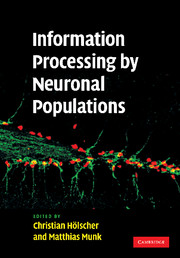Book contents
- Frontmatter
- Contents
- List of contributors
- Part I Introduction
- Part II Organization of neuronal activity in neuronal populations
- Part III Neuronal population information coding and plasticity in specific brain areas
- Part IV Functional integration of different brain areas in information processing and plasticity
- Part V Disturbances of population activity as the basis of schizophrenia
- Part VI Summary, conclusion, and future targets
- 18 Summary of chapters, conclusion, and future targets
- Index
18 - Summary of chapters, conclusion, and future targets
Published online by Cambridge University Press: 14 August 2009
- Frontmatter
- Contents
- List of contributors
- Part I Introduction
- Part II Organization of neuronal activity in neuronal populations
- Part III Neuronal population information coding and plasticity in specific brain areas
- Part IV Functional integration of different brain areas in information processing and plasticity
- Part V Disturbances of population activity as the basis of schizophrenia
- Part VI Summary, conclusion, and future targets
- 18 Summary of chapters, conclusion, and future targets
- Index
Summary
Summary of chapters
The different chapters discuss a wide range of concepts, techniques, and strategies of how to investigate the issue of information encoding in neuronal populations. The diversity clearly shows that the question is of central interest, that there is a lively competition of ideas and concepts, and that it is now possible to address the issue adequately by using new technology, the lack of which hampered discoveries in the past. The multileveled concepts described here show that there will not be a simple model or coding mechanism that can adequately explain how the brain works.
Part II: Organization of neuronal activity in neuronal populations
In this section, discussion focused on what general rules and physiological processes are in place that govern information encoding, processing, network formation, and laying down of memory traces.
In Chapter 2, Edward Mann and Ole Paulsen gave a detailed overview of the cellular mechanisms that underlie the establishment of oscillating networks. The fact that a multitude of specialized ion channels, interneuron subtypes, and neuronal projections are in place to establish defined oscillations in a controlled way clearly supports their concept that this mechanism is important for organizing brain processes. This point was also well illustrated by Brian Bland in Chapter 12, where he showed which “purpose-built” basal brain nuclei and projections are involved in the induction and control of theta oscillations in areas throughout the brain.
- Type
- Chapter
- Information
- Information Processing by Neuronal Populations , pp. 433 - 469Publisher: Cambridge University PressPrint publication year: 2008

